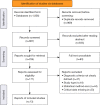Risk factors of cerebral palsy in children: a systematic review and meta-analysis
- PMID: 35558974
- PMCID: PMC9085939
- DOI: 10.21037/tp-22-78
Risk factors of cerebral palsy in children: a systematic review and meta-analysis
Abstract
Background: This study aimed to explore the main risk factors for cerebral palsy in children by meta-analysis of the literature on the risk factors of cerebral palsy.
Methods: We performed a literature search of the PubMed, EMBASE, Medline, and CENTRAL databases using the following search terms: ("cerebrl plsy" or "cerebrl plsis" or "infantile cerebral palsy") and ("risk factors"). Case-control or cohort studies of children with cerebral palsy and healthy children were included for meta-analysis. The Newcastle-Ottawa Scale (NOS) of case-control studies was used to evaluate the quality of the included studies. The Chi-square test was used to test the heterogeneity of the literature. This study used subgroup analysis and sensitivity analysis to identify sources of heterogeneity. If subgroup analyses and sensitivity analyses could not identify the source of heterogeneity, no pooling between study results was performed, and only individual study results were described. In this study, Egger's test was used to test for publication bias. The random-effects model was used when heterogeneity existed, and the fixed-effect model was applied when heterogeneity did not exist.
Results: A total of 1,836 related articles were retrieved. After screening, 13 articles were included in the analysis, involving a total of 2,489 children with cerebral palsy and 4,782 children without cerebral palsy. None of the included articles achieved a NOS score of 9, four articles scored 8, eight articles scored 7, and one article scored 6. Meta-analysis showed that maternal hypertension during pregnancy, premature rupture of membranes, premature delivery and emergency cesarean section were risk factors for cerebral palsy in children, and there was no heterogeneity among the literatures and no publication bias.
Conclusions: This study identified gestational hypertension, preterm birth, premature rupture of membranes, and emergency cesarean section as risk factors for cerebral palsy in children through meta-analysis, providing a reference for risk monitoring and clinical intervention.
Keywords: Children; cerebral palsy; risk factors.
2022 Translational Pediatrics. All rights reserved.
Conflict of interest statement
Conflicts of Interest: All authors have completed the ICMJE uniform disclosure form (available at https://tp.amegroups.com/article/view/10.21037/tp-22-78/coif). The authors have no conflicts of interest to declare.
Figures









Similar articles
-
Maternal Infection During Pregnancy and Risk of Cerebral Palsy in Children: A Systematic Review and Meta-analysis.J Child Neurol. 2021 Apr;36(5):385-402. doi: 10.1177/0883073820972507. Epub 2020 Nov 24. J Child Neurol. 2021. PMID: 33231118
-
Uterine fibroids increase the risk of preterm birth and other adverse birth events: a systematic review and meta-analysis.Transl Pediatr. 2022 Jun;11(6):978-986. doi: 10.21037/tp-22-215. Transl Pediatr. 2022. PMID: 35800281 Free PMC article.
-
Proportion of good oral hygiene and mean value oral hygiene index among children with cerebral palsy in Africa and Asia: a systematic review and meta-analysis.BMC Oral Health. 2024 Dec 5;24(1):1480. doi: 10.1186/s12903-024-05264-9. BMC Oral Health. 2024. PMID: 39639294 Free PMC article.
-
[Meta analysis of whether cytoreductive surgery combined with hyperthermic intraperitoneal chemotherapy can improve survival in patients with colorectal cancer peritoneal metastasis].Zhonghua Wei Chang Wai Ke Za Zhi. 2021 Mar 25;24(3):256-263. doi: 10.3760/cma.j.cn.441530-20201111-00604. Zhonghua Wei Chang Wai Ke Za Zhi. 2021. PMID: 34645170 Chinese.
-
Maternal Infection during Pregnancy and Attention-Deficit Hyperactivity Disorder in Children: A Systematic Review and Meta-Analysis.Iran J Public Health. 2022 Dec;51(12):2674-2687. doi: 10.18502/ijph.v51i12.11458. Iran J Public Health. 2022. PMID: 36742242 Free PMC article. Review.
Cited by
-
Short-Term and Long-Term Mortality Risk After Preterm Birth.JAMA Netw Open. 2024 Nov 4;7(11):e2445871. doi: 10.1001/jamanetworkopen.2024.45871. JAMA Netw Open. 2024. PMID: 39565625 Free PMC article.
-
Long-term health outcomes of preterm birth: a narrative review.Front Pediatr. 2025 Apr 23;13:1565897. doi: 10.3389/fped.2025.1565897. eCollection 2025. Front Pediatr. 2025. PMID: 40336800 Free PMC article. Review.
-
Predicting the brain age of children with cerebral palsy using a two-dimensional convolutional neural networks prediction model without gray and white matter segmentation.Front Neurol. 2022 Nov 24;13:1040087. doi: 10.3389/fneur.2022.1040087. eCollection 2022. Front Neurol. 2022. PMID: 36504669 Free PMC article.
-
Inflammatory Markers in the Blood of Spastic Cerebral Palsy Children: A Case-Control Study.Children (Basel). 2025 Mar 9;12(3):343. doi: 10.3390/children12030343. Children (Basel). 2025. PMID: 40150625 Free PMC article.
-
Determinants of cerebral palsy in children: systematic review.Sudan J Paediatr. 2023;23(2):126-144. doi: 10.24911/SJP.106-1670589241. Sudan J Paediatr. 2023. PMID: 38380410 Free PMC article. Review.
References
LinkOut - more resources
Full Text Sources
